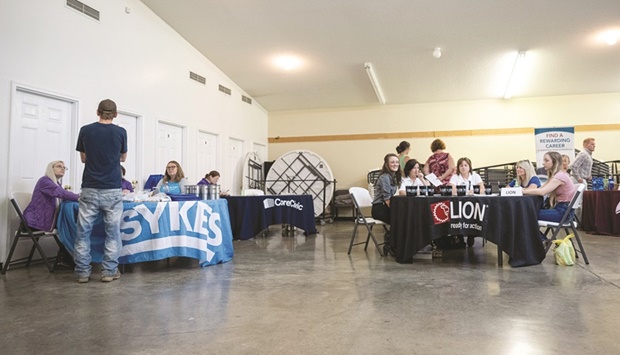US employers extended a hiring spree last month despite a record spike in Covid-19 infections and related business closures, with surging wages adding further pressure on the Federal Reserve to raise interest rates.
Non-farm payrolls increased 467,000 in January in a broad-based advance that followed substantial upward revisions to the prior two months, a Labor Department report showed yesterday. The unemployment rate ticked up to 4%, and average hourly earnings jumped.
The median estimate in a Bloomberg survey of economists called for a 125,000 advance in payrolls, though forecasts ranged widely.
A variety of factors including Omicron, seasonal adjustment and the way workers who are home sick are factored in make interpreting the January data challenging.
The surprise display of strength suggests the labour market continues to improve, despite the temporary disruption from record-high levels of coronavirus infections and the resulting absenteeism from work.
The data further reinforce Fed Chair Jerome Powell’s description last week of the labour market as “strong” and validate the central bank’s intention to raise interest rates in March to combat the highest inflation in nearly 40 years.
Treasury yields surged and the S&P 500 was mixed. Investors began to price in the slight possibility of a sixth quarter-point boost by the end of this year, while continuing to see a March increase as a lock and nudging up the chance of a 50-basis-point jump.
“This seals the deal for a March hike,” said Ryan Sweet, head of monetary policy research at Moody’s Analytics Inc, who added that the chance of a half-point increase is still unlikely.
“The Fed is going to take away from this that the economy is barrelling towards full employment and this will make it more difficult for them to gracefully engineer a soft landing.”
After adjustments to reflect updated population estimates, the labour force participation rate - the share of the population that is working or looking for work - increased to 62.2%, thanks to gains among both men and women.
Without that impact, the rate was unchanged from 61.9% in December.
Meanwhile, the Labor Department’s report showed average hourly earnings rose 0.7% in January and 5.7% from a year ago, further fanning concerns about the persistence of inflation. The average workweek dropped.
The faster-than-expected advance in pay could fuel market concerns about the Fed taking an even more aggressive stance on inflation this year.
Despite the better-than-expected report, the impact of Omicron on the labour market in January was substantial. There were 3.6mn employed Americans not at work due to illness, more than double that in December.
Meanwhile, 6mn people were unable to work in the month because their employer closed or lost business due to the pandemic, roughly twice that in December.
The jobs report is good news for the White House, which had been tempering expectations ahead of time out of concern that the Omicron variant would negatively affect the data.
The job gains were broad based, led by a 151,000 advance in leisure and hospitality. Transportation and warehousing, retail trade and professional and business services also posted solid increases.
The solid employment growth in several categories may reflect businesses choosing to retain more holiday workers than normal in the face of a tight labour market.
“This is much more about what it tells us about those revisions, but what it tells us today: this is the labour market screaming,” Jeff Rosenberg, a senior portfolio manager at BlackRock Inc, said on Bloomberg Television.
Looking at unemployment rates by demographics, most groups were relatively little changed from the prior month. Black Americans continue to have the highest jobless rate at 6.9%, double that of White workers.
The report also included revisions to total nonfarm employment as part of the BLS annual benchmark revision.

Job seekers speak with recruiters during a job fair at a community centre in Beattyville, Kentucky. US employers extended a hiring spree last month despite a record spike in Covid-19 infections and related business closures, with surging wages adding further pressure on the Federal Reserve to raise interest rates.


